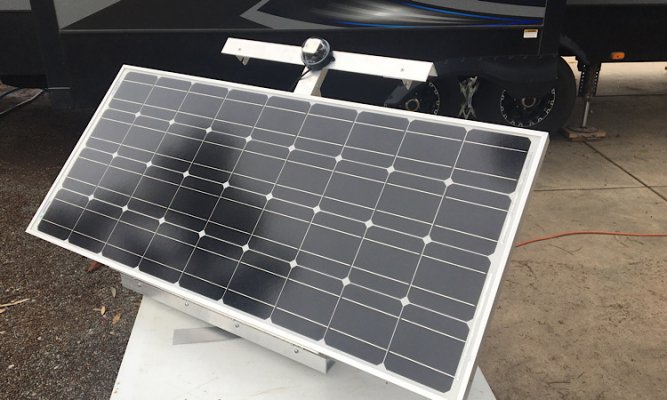Having recently returned from a solar project in Goa, I found myself like many others, "grounded"
with time on my hands from the consequences of the COVID-19 virus, I'm semi-retired, so I was thinking of
ways to occupy my spare time and decided to resurrect an old project from some 30+ years ago.
This is a solar tracker with a difference. the design is based on a 3 support gimbal assembly
much like a tripod. each support arm is a linear actuator attached to a ball joint assembly to a platform.
hence, by extending or retracting each arm a certan distance the
top platform ( a solar panel ) can be adjusted to point in any direction.
My eldest grandson ( 15 ) who is mathematically adept, also expressed an interest in this project, so he will
now have the chance to learn some interesting disciplines such as motor control, advanced math, software, mechanics
and of course solar engineering..
I decided to make the project somewhat ambitious, just for the fun of it..
the unit will be semi-autonomous, the concept is to have the unit deploy the tracker(s) on an RV
with little to no intervention from the user in that the tracker logic will determine the RV's location from
a GPS unit, the orientation from a compass module and then set the panel's asimuth and elevation automatically
by computing the sun's position. I have a collection of various software ( thanks to NASA and NREL ) that does the calculations.
this will be incorporated into the motor control software that we will write.
this is at the moment just a pure educational exercise, but if it is economically feasable, I may
attempt to market this, i have seen nothing like it for an RV, the major challenges are of course cost and space.
i'll update with pictures and posts in due course..
with time on my hands from the consequences of the COVID-19 virus, I'm semi-retired, so I was thinking of
ways to occupy my spare time and decided to resurrect an old project from some 30+ years ago.
This is a solar tracker with a difference. the design is based on a 3 support gimbal assembly
much like a tripod. each support arm is a linear actuator attached to a ball joint assembly to a platform.
hence, by extending or retracting each arm a certan distance the
top platform ( a solar panel ) can be adjusted to point in any direction.
My eldest grandson ( 15 ) who is mathematically adept, also expressed an interest in this project, so he will
now have the chance to learn some interesting disciplines such as motor control, advanced math, software, mechanics
and of course solar engineering..
I decided to make the project somewhat ambitious, just for the fun of it..
the unit will be semi-autonomous, the concept is to have the unit deploy the tracker(s) on an RV
with little to no intervention from the user in that the tracker logic will determine the RV's location from
a GPS unit, the orientation from a compass module and then set the panel's asimuth and elevation automatically
by computing the sun's position. I have a collection of various software ( thanks to NASA and NREL ) that does the calculations.
this will be incorporated into the motor control software that we will write.
this is at the moment just a pure educational exercise, but if it is economically feasable, I may
attempt to market this, i have seen nothing like it for an RV, the major challenges are of course cost and space.
i'll update with pictures and posts in due course..

